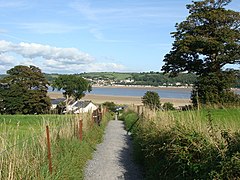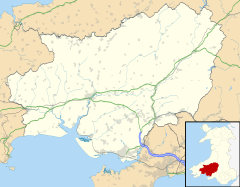Ferryside
Ferryside
|
|
|---|---|
 Ferryside seen from Llansteffan across the river Towy |
|
| Ferryside shown within Carmarthenshire | |
| OS grid reference | SN366103 |
| Community | |
| Principal area | |
| Ceremonial county | |
| Country | Wales |
| Sovereign state | United Kingdom |
| Postcode district | SA17 |
| Police | Dyfed-Powys |
| Fire | Mid and West Wales |
| Ambulance | Welsh |
| EU Parliament | Wales |
| UK Parliament | |
| Welsh Assembly | |
Ferryside (Welsh: Glan-y-fferi) is a village in the community of St Ishmael, Carmarthenshire, Wales. It is 8.5 miles (13.7 km) south of Carmarthen near the mouth of the River Tywi and close to sandy beaches. Originally a ferry crossing, then becoming a fishing village, it has developed as a holiday and retirement area. The village has its own lifeboat station and was the first village in the UK to switch from analogue to digital television.
Originating as a landing-place on the ferry route to Llansteffan (the ferry was used by Giraldus Cambrensis in 1188), Ferryside developed as a fishing village. In 1844 the population of the parish was 895.
Much of the village developed after 1852, when it became linked to Carmarthen and Swansea by Isambard Kingdom Brunel's South Wales Railway.
There is a school that has been there for over 150 years.
The parish church is St Ishmael's, built on a rock near the shore. In 2006, the graveyard and grounds were selected for an innovative project aimed at encouraging biodiversity in churchyards. There are two chapels near the centre of the village and another church, St Thomas, in the centre of the village.
Ferryside has a post office, a public house (Poachers Rest), a sports and social club (previously the rugby club), a general store, hotel (Three Rivers Hotel & Spa), restaurant, antiques shop and caravan park.
Ferryside railway station has regular rail connections to London Paddington, Pembroke Dock, Milford Haven, Carmarthen, Swansea and Cardiff. Bus services connect to Carmarthen and Llanelli. The ferry service across the River Tywi to Llansteffan was discontinued in the 1950s but plans were submitted in March 2017 to resume the service.
...
Wikipedia

